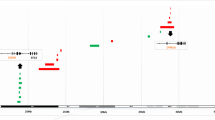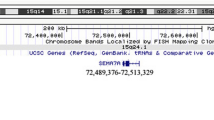Abstract
Diagnosis and treatment of velocardiofacial syndrome (VCFS) with variable genotypes and phenotypes are considered to be very complicated. Establishing an exact correlation between the phenotypes and genotypes of VCFS is still a challenging. In this paper, 88 Chinese VCFS patients were divided into five groups based on palatal anomalies and one or two of other four common phenotypes, and copy number variations (CNVs) were detected using multiplex ligation-dependent probe amplification (MLPA), array comparative genomic hybridization (aCGH) and quantitative polymerase chain reaction. The findings showed that palatal anomalies and characteristic malformation of face were important indicators for 22q11.2 microdeletion, and there was difference in the phenotypic spectrum between the duplication and deletion of 22q11.2. MLPA was a highly cost-effective, sensitive and preferred method for patients with 22q11.2 deletion or duplication. Our results also firstly reported that all three patients who simultaneously exhibited palatal anomalies and cognitive disorder, without other phenotypes, have Top3b duplication, which strongly suggested that Top3b may be a pathogenic gene for these patients. Further, the findings showed that patients with palatal anomalies and congenital heart disease or immune deficiency, with or without other uncommon phenotypes, exhibited heterogeneity in CNVs, including 4q34.1-qter, 6q25.3, 4q23, Xp11.4, 13q21.1, 17q23.2, 7p21.3, 2p11.2, 11q24.3 and 16q23.3, and some possible pathogenic genes, including BCOR, PRR20A, TBX2, SMYD1, KLKB1 and TULP4 have been suggested. For these patients, aCGH, whole genomic sequencing, combined with references and phenomics database to find pathogenic gene, may be choices of priority. Taking these findings together, we offered an alternative method for diagnosis of Chinese VCFS patients based on this phenotypic strategy.




Similar content being viewed by others
References
Chengle H., Kaihong D. and Fuzhi B. 2010 Association analysis of the poliovirus receptor related-2 gene in patients with nonsyndromic cleft lip with or without cleft palate. DNA Cell Biol. 29, 681–685.
Davoody A., Chen I. P., Nanda R., Uribe F. and Reichenberger E. J. 2012 Oculofaciocardiodental syndrome: a rare case and review of the literature. Cleft Palate Craniofac. J. 49, e55–e60.
Doughan M., Spellmon N., Li C. and Yang Z. 2016 SMYD proteins in immunity: dawning of a new era. AIMS Biophys. 3, 450–455.
Ensenauer R. E., Adeyinka A., Flynn H. C., Michels V. V., Lindor N. M., Dawson D. B. et al. 2003 Microduplication 22q11.2, an emerging syndrome: clinical, cytogenetic, and molecular analysis of thirteen patients. Am. J. Hum. Genet. 73, 1027–1040.
Fava C., Danese E., Montagnana M., Sjogren M., Almgren P., Guidi G. C. et al. 2011 A variant upstream of the CDH13 adiponectin receptor gene and metabolic syndrome in Swedes. Am. J. Cardiol. 108, 1432–1437.
Girirajan S., Rosenfeld J. A., Coe B. P., Parikh S., Friedman N., Goldstein A. et al. 2012 Phenotypic heterogeneity of genomic disorders and rare copy-number variants. N. Engl. J. Med. 367, 1321–1331.
Gittleman H. R., Merkulova A., Alhalabi O., Stavrou E. X., Veigl M. L., Barnholtz-Sloan J. S. et al. 2016 A cross-sectional study of KLKB1 and PRCP polymorphisms in patient samples with cardiovascular disease. Front. Med. (Lausanne) 3, 17.
Guo T., Chung J. H., Wang T., McDonald-McGinn D. M., Kates W. R., Hawula W. et al. 2015 Histone modifier genes Alter conotruncal heart phenotypes in 22q11.2 deletion syndrome. Am. J. Hum. Genet. 97, 869–877.
Hood R. L., Schenkel L. C., Nikkel S. M., Ainsworth P. J., Pare G., Boycott K. M. et al. 2016 The defining DNA methylation signature of Floating–Harbor syndrome. Sci. Rep. 6, 38803.
Horn D., Chyrek M., Kleier S., Luttgen S., Bolz H., Hinkel G. K. et al. 2005 Novel mutations in BCOR in three patients with oculo-facio-cardio-dental syndrome, but none in Lenz microphthalmia syndrome. Eur. J. Hum. Genet. 13, 563–569.
Jalali G. R., Vorstman J. A., Errami A., Vijzelaar R., Biegel J., Shaikh T. et al. 2008 Detailed analysis of 22q11.2 with a high density MLPA probe set. Hum. Mutat. 29, 433–440.
Jussila M., Aalto A. J., Sanz Navarro M., Shirokova V., Balic A., Kallonen A. et al. 2015 Suppression of epithelial differentiation by Foxi3 is essential for molar crown patterning. Development 142, 3954–3963.
Kaufman C. S., Genovese A. and Butler M. G. 2016 Deletion of TOP3B is associated with cognitive impairment and facial dysmorphism. Cytogenet. Genome Res. 150, 106–111.
Kobrynski L. J. and Sullivan K. E. 2007 Velocardiofacial syndrome, DiGeorge syndrome: the chromosome 22q11.2 deletion syndromes. Lancet 370, 1443–1452.
Kohler S., Schulz M. H., Krawitz P., Bauer S., Dolken S., Ott C. E. et al. 2009 Clinical diagnostics in human genetics with semantic similarity searches in ontologies. Am. J. Hum. Genet. 85, 457–464.
Kohler S., Vasilevsky N. A., Engelstad M., Foster E., McMurry J., Ayme S. et al. 2017 The human phenotype ontology in 2017. Nucleic Acids Res. 45, D865–D876.
Kruszka P., Addissie Y. A., McGinn D. E., Porras A. R., Biggs E., Share M. et al. 2017 22q11.2 deletion syndrome in diverse populations. Am. J. Med. Genet. A. 173, 879–888.
Kwan K. Y. and Wang J. C. 2001 Mice lacking DNA topoisomerase IIIbeta develop to maturity but show a reduced mean lifespan. Proc. Natl. Acad. Sci. USA 98, 5717–5721.
Kwan K. Y., Moens P. B. and Wang J. C. 2003 Infertility and aneuploidy in mice lacking a type IA DNA topoisomerase III beta. Proc. Natl. Acad. Sci. USA 100, 2526–2531.
Kwan K. Y., Greenwald R. J., Mohanty S., Sharpe A. H., Shaw A. C. and Wang J. C. 2007 Development of autoimmunity in mice lacking DNA topoisomerase 3beta. Proc. Natl. Acad. Sci. USA 104, 9242–9247.
Lopez-Rivera E., Liu Y. P., Verbitsky M., Anderson B. R., Capone V. P., Otto E. A. et al. 2017 Genetic drivers of kidney defects in the DiGeorge syndrome. N. Engl. J. Med. 376, 742–754.
McDonald-McGinn D. M., Sullivan K. E., Marino B., Philip N., Swillen A., Vorstman J. A. et al. 2015 22q11.2 deletion syndrome. Nat. Rev. Dis. Primers 1, 15071.
Mesbah K., Rana M. S., Francou A., van Duijvenboden K., Papaioannou V. E., Moorman A. F. et al. 2012 Identification of a Tbx1/Tbx2/Tbx3 genetic pathway governing pharyngeal and arterial pole morphogenesis. Hum. Mol. Genet. 21, 1217–1229.
Panamonta V., Wichajarn K., Chaikitpinyo A., Panamonta M., Pradubwong S. and Chowchuen B. 2016a Birth prevalence of chromosome 22q11.2 deletion syndrome: asystematic review of population-based studies. J. Med. Assoc. Thailand 99, S187–S193.
Panamonta V., Wichajarn K., Wongswadiwat Y., Panamonta M., Pradubwong S. and Chowchuen B. 2016b Assessment of chromosome 22q11.2 deletion in patients with isolated cleft palate: asystematic review of prospective studies. J. Med. Assoc. Thailand 99, S194–S198.
Perez E. and Sullivan K. E. 2002 Chromosome 22q11.2 deletion syndrome (DiGeorge and velocardiofacial syndromes). Curr. Opin. Pediatr. 14, 678–683.
Poirsier C., Besseau-Ayasse J., Schluth-Bolard C., Toutain J., Missirian C., Le Caignec C. et al. 2016 A French multicenter study of over 700 patients with 22q11 deletions diagnosed using FISH or aCGH. Eur. J. Hum. Genet. 24, 844–851.
Radio F. C., Bernardini L., Loddo S., Bottillo I., Novelli A., Mingarelli R. et al. 2010 TBX2 gene duplication associated with complex heart defect and skeletal malformations. Am. J. Med. Genet. A. 152A, 2061–2066.
Rasmussen T. L., Ma Y., Park C. Y., Harriss J., Pierce S. A., Dekker J. D. et al. 2015 Smyd1 facilitates heart development by antagonizing oxidative and ER stress responses. PLoS One 10, e0121765.
Song T., Shi J., Guo Q., Lv K., Jiao X., Hu T. et al. 2015 Association between NOGGIN and SPRY2 polymorphisms and nonsyndromic cleft lip with or without cleft palate. Am. J. Med. Genet. A 167, 137–141.
Stoll G., Pietilainen O. P., Linder B., Suvisaari J., Brosi C., Hennah W. et al. 2013 Deletion of TOP3beta, a component of FMRP-containing mRNPs, contributes to neurodevelopmental disorders. Nat. Neurosci. 16, 1228–1237.
Tassano E., Jagannathan V., Drogemuller C., Leoni M., Hytonen M. K., Severino M. et al. 2015 Congenital aural atresia associated with agenesis of internal carotid artery in a girl with a FOXI3 deletion. Am. J. Med. Genet. A. 167A, 537–544.
van Duyvenvoorde H. A., Lui J. C., Kant S. G., Oostdijk W., Gijsbers A. C., Hoffer M. J. et al. 2014 Copy number variants in patients with short stature. Eur. J. Hum. Genet. 22, 602–609.
Vieira A. R., de Carvalho F. M., Johnson L., DeVos L., Swailes A. L., Weber M. L. et al. 2015 Fine mapping of 6q23.1 identifies TULP4 as contributing to clefts. Cleft. Palate. Craniofac. J. 52, 128–134.
Wamstad J. A. and Bardwell V. J. 2007 Characterization of BCOR expression in mouse development. Gene Expression Patterns 7, 550–557.
Wu D., Chen Y., Xu C., Wang K., Wang H., Zheng F. et al. 2013 Characteristic face: a key indicator for direct diagnosis of 22q11.2 deletions in Chinese velocardiofacial syndrome patients. PLoS One 8, e54404.
Xu D., Shen W., Guo R., Xue Y., Peng W., Sima J. et al. 2013 Top3beta is an RNA topoisomerase that works with fragile X syndrome protein to promote synapse formation. Nat. Neurosci. 16, 1238–1247.
Yang H., Robinson P. N. and Wang K. 2015 Phenolyzer: phenotype-based prioritization of candidate genes for human diseases. Nat. Methods 12, 841–843.
Zemojtel T., Kohler S., Mackenroth L., Jager M., Hecht J., Krawitz P. et al. 2014 Effective diagnosis of genetic disease by computational phenotype analysis of the disease-associated genome. Sci. Transl. Med. 6, 252ra123.
Acknowledgements
This work was supported by the Interdisciplinary Program of Shanghai Jiaotong University (nos. YG2016MS08 and YG2016QN11), the National Key Research and Development Program of China (no. 2016YFC1000502), the National Natural Science Foundation of China (no. 81300842) and Morning Star Rewarding Fund of Shanghai Jiaotong University.
Author information
Authors and Affiliations
Corresponding authors
Additional information
Corresponding Editor: Indrajit Nanda
Electronic supplementary material
Below is the link to the electronic supplementary material.
Rights and permissions
About this article
Cite this article
Wu, D., Chen, Y., Chen, Q. et al. Clinical presentation and genetic profiles of Chinese patients with velocardiofacial syndrome in a large referral centre. J Genet 98, 42 (2019). https://doi.org/10.1007/s12041-019-1090-5
Received:
Revised:
Accepted:
Published:
DOI: https://doi.org/10.1007/s12041-019-1090-5




